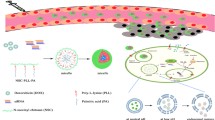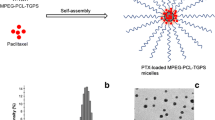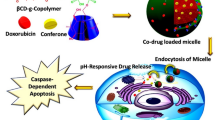ABSTRACT
Purpose
To evaluate novel mixed polymeric micelles based on monomethoxy poly(ethylene glycol)-poly(D,L-lactic acid) (mPEG-PLA) and Pluronic L61 for delivery of paclitaxel (PTX) to circumvent unfavorable effects resulting from Cremophore EL in Cremophore EL-based PTX formulation and overcoming multidrug resistance (MDR) in tumor cells at the same time.
Methods
PTX-loaded plain micelles and mixed micelles were prepared and characterized by determining PTX release in vitro, MDR reversal effect in human breast cancer MDR MCF-7/ADR cell sublines and pharmacokinetics in vivo.
Results
Both PTX-loaded plain micelles and mixed micelles had similar in vitro release profile. Mixed micellar PTX significantly reduced IC50 of PTX in MCF-7/ADR cells compared to free PTX and plain micellar PTX, and mixed micelles substantially enhanced cellular accumulation of R 123 in MCF-7/ADR cells compared to free R123 and plain micelles. PTX-loaded mixed micelles with lower content of L61 exhibited comparable cytotoxicity to that observed with Cremophore EL-based PTX formulation in inhibiting the growth of MCF-7/ADR cells. Moreover, plain micelles and mixed micelles retained the pharmacokinetic characteristics of PTX in rats compared with Cremophore EL-based PTX formulation.
Conclusion
This study suggested that the mixed micelles could enhance delivery of PTX and cell-killing effect for MDR MCF-7/ADR cells.







Similar content being viewed by others
REFERENCES
Stein WD, Bates SE, Fojo T. Intractable cancers: the many faces of multidrug resistance and the many targets it presents for therapeutic attack. Curr Drug Targets. 2004;5:333–46.
Calderwood SK, Khaleque MA, Sawyer DB, Ciocca DR. Heat shock proteins in cancer: chaperones of tumorigenesis. Trends Biochem Sci. 2006;31:164–72.
Kirkin V, Joos S, Zornig M. The role of Bcl-2 family members in tumorigenesis. Biochim Biophys Acta. 2004;1644:229–49.
Szakacs G, Paterson JK, Ludwig JA, Booth-Genthe C, Gottesman MM. Targeting multidrug resistance in cancer. Nat Rev Drug Discov. 2006;5:219–34.
Duhem C, Ries F, Dicato M. What does Multidrug Resistance (MDR) expression mean in the clinic? Oncologist. 1996;1:151–8.
Gottesman MM, Fojo T, Bates SE. Multidrug resistance in cancer: Role of ATP-dependent transporters. Nat Rev Cancer. 2002;2:48–58.
Gottesman MM, Pastan I, Ambudkar SV. P-glycoprotein and multi drug resistance. Curr Opin Genet Dev. 1996;6:610–17.
Lage H. MDR1/P-glycoprotein (ABCB1) as target for RNA interference-mediated reversal of multidrug resistance. Curr Drug Targets. 2006;7:813–21.
Ferry DR, Traunecker H, Kerr DJ. Clinical trials of P-glycoprotein reversal in solid tumours. Eur J Cancer. 1996;32A:1070–81.
Krishna R, Mayer LD. Multidrug resistance (MDR) in cancer. Mechanisms, reversal using modulators of MDR and the role of MDR modulators in influencing the pharmacokinetics of anticancer drugs. Eur J Pharm Sci. 2000;11:265–83.
Rowinsky EK, Smith L, Wang YM, Chaturvedi P, Villalona M, Campbell E et al. Phase I and pharmacokinetic study of paclitaxel in combination with biricodar, a novel agent that reverses multidrug resistance conferred by overexpression of both MDR1 and MRP. J Clin Oncol. 1998;16:2964–76.
Thomas H, Coley HM. Overcoming multidrug resistance in cancer: an update on the clinical strategy of inhibiting p-glycoprotein. Cancer Control. 2003;10:159–65.
Werle M. Natural and synthetic polymers as inhibitors of drug efflux pumps. Pharm Res. 2008;25:500–11.
Kabanov A, Alakhov V. Pluronic block copolymers in drug delivery: from micellar nanocontainers to biological response modifiers. Crit Rev Ther Drug Carr Syst. 2002;19:1–72.
Sharma AK, Zhang L, Li S, Kelly DL, Alakhov VY, Batrakova EV et al. Prevention of MDR development in leukemia cells by micelle-forming polymeric surfactant. J Control Release. 2008;131:220–7.
Kabanov AV, Batrakova EV, Alakhov VY. Pluronic block copolymers for overcoming drug resistance in cancer. Adv Drug Deliv Rev. 2002;54:759–79.
Venne A, Li S, Mandeville R, Kabanov A, Alakhov V. Hypersensitizing effect of pluronic L61 on cytotoxic activity, transport, and subcellular distribution of doxorubicin in multiple drug-resistant cells. Cancer Res. 1996;56:3626–9.
Alakhov V, Moskaleva E, Batrakova EV, Kabanov AV. Hypersensitization of multidrug resistant human ovarian carcinoma cells by pluronic P85 block copolymer. Bioconjug Chem. 1996;7:209–16.
Batrakova EV, Li S, Alakhov VYu, Elmquist WF, Miller DW, Kabanov AV. Sensitization of cells overexpressing multidrug-resistant proteins by Pluronic P85. Pharm Res. 2003;20:1581–90.
Batrakova EV, Li S, Elmquist WF, Miller DW, Alakhov VY, Kabanov AV. Mechanism of sensitization of MDR cancer cells by Pluronic block copolymers: Selective energy depletion. Br J Cancer. 2001;85:1987–97.
Werle M. Natural and synthetic polymers as inhibitors of drug efflux pumps. Pharm Res. 2008;25:500–11.
Kataoka K, Harada A, Nagasaki Y. Block copolymer micelles for drug delivery: Design, characterization and biological significance. Adv Drug Deliv Rev. 2001;47:113–31.
Ai H, Flask C, Weinberg B, Shuai X, Pagel MD, Farrell D et al. Magnetite-loaded polymeric micelles as ultrasensitive magnetic-resonance probe. Adv Mater. 2005;17:1949–52.
Croy SR, Kwon GS. Polymeric micelles for drug delivery. Curr Pharm Design. 2006;12:4669–84.
Le Garrec D, Gori S, Luo L, Lessard D, Smith DC, Yessine M-A et al. Poly(N-vinylpyrrolidone)-block-poly(D, L-lactide) as a new polymeric solubilizer for hydrophobic anticancer drugs: in vitro and in vivo evaluation. J Control Release. 2004;99:83–101.
Strickley RG. Solubilizing excipients in oral and injectable formulations. Pharm Res. 2004;21:201–30.
Kwon GS. Polymeric micelles for delivery of poorly water-soluble compounds. Crit Rev Therap Drug Carrier Syst. 2003;20:357–403.
Barratt G. Colloidal drug carriers: achievements and perspectives. Cell Mol Life Sci. 2003;60:21–37.
Danson S, Ferry D, Alakhov V, Margison J, Kerr D, Jowle D et al. Phase I dose escalation and pharmacokinetic study of pluronic polymer-bound doxorubicin (SP1049C) in patients with advanced cancer. Br J Cancer. 2004;90:2085–91.
Matsumura Y, Hamaguchi T, Ura T, Muro K, Yamada Y, Shimada Y et al. Phase I clinical trial and pharmacokinetic evaluation of NK911, a micelle-encapsulated doxorubicin. Br J Cancer. 2004;91:1775–81.
Mizumura Y, Matsumura Y, Yokoyama M, Okano T, Kawaguchi T, Moriyasu F et al. Incorporation of the anticancer agent KRN5500 into polymeric micelles diminishes the pulmonary toxicity. Jpn J Cancer Res. 2002;93:1237–43.
Zhang XC, Burt HM, Hoff DV, Dexter D, Mangold G, Degen D et al. An investigation of the antitumor activity and biodistribution of polymeric micellar paclitaxel. Cancer Chemother Pharmacol. 1997;40:81–6.
Li X, Huang Y, Chen X, Zhou Y, Zhang Y, Li P et al. Self-assembly and characterization of Pluronic P105 micelles for liver-targeted delivery of silybin. J Drug Target. 2009;17:739–50.
Yang XQ, Deng WJ, Fu LW, Blanco E, Gao JM, Quan DP et al. Folate-functionalized polymeric micelles for tumor targeted delivery of a potent multidrug-resistance modulator FG020326. J Biomed Mater Res. 2008;86A:48–60.
Wang YZ, Yu L, Han LM, Sha XY, Fang XL. Difunctional Pluronic copolymer micelles for paclitaxel delivery: Synergistic effect of folate-mediated targeting and Pluronic-mediated overcoming multidrug resistance in tumor cell lines. Inter J Pharm. 2007;337:63–73.
Chiappetta DA, Sosnik A. Poly(ethylene oxide)–poly(propylene oxide) block copolymer micelles as drug delivery agents: Improved hydrosolubility, stability and bioavailability of drugs. Eur J Pharm Biopharm. 2007;66:303–17.
Singla AK, Garg A, Aggarwal D. Paclitaxel and its formulations. Inter J Pharm. 2002;235:179–92.
Gelderblom H, Verweij J, Nooter K, Sparreboom A. Cremophor EL: the drawbacks and advantages of vehicle selection for drug formulation. Eur J Cancer. 2001;37:1590–8.
Weiss RB, Donehower RC, Wiernik PH, Ohnuma T, Gralla RJ, Trump DL et al. Hypersensitivity reactions from taxol. J Clin Oncol. 1990;8:1263–8.
Geney R, Ungureanu M, Li D, Ojima I. Overcoming multidrug resistance in taxane chemotherapy. Clin Chem Lab Med. 2002;40:918–25.
Zhang X, Jackson JK, Burt HM. Development of amphiphilic diblock copolymers as micellar carriers of taxol. Inter J Pharm. 1996;132:195–206.
Kim SC, Kim DW, Shim YH, Bang JS, Oh HS, Kim SW et al. In vivo evaluation of polymeric micellar paclitaxel formulation: toxicity and efficacy. J Control Release. 2001;72:191–202.
Yang ZL, Li XR, Yang KW, Liu Y. Amphotericin B-loaded poly(ethylene glycol)-poly(lactide) micelles: Preparation, freeze-drying and in vitro release. J Biomed Mater Res. 2008;85A:539–46.
Wilhelm M, Zhao CL, Wang YC, Xu RL, Winnik MA. Macromolecules. 1999;24:1033–40.
Huh KM, Lee SC, Cho YW, Lee J, Jeong JH, Park K. Hydrotropic polymer micelle system for delivery of paclitaxel. J Control Release. 2005;101:59–68.
Batrakova E, Lee S, Li S, Venne A, Alakhov V, Kabanov A. Fundamental relationships between the composition of pluronic block copolymers and their hypersensitization effect in MDR cancer cells. Pharm Res. 1999;16:1373–9.
Jones MC, Leroux JC. Polymeric micelles—a new generation of colloidal drug carriers. Eur J Pharm Biopharm. 1999;48:101–11.
Choa YW, Leeb J, Leeb SC, Huhb KM, Park K. Hydrotropic agents for study of in vitro paclitaxel release from polymeric micelles. J Control Release. 2004;97:249–57.
Lee SC, Kim C, Kwon IC, Chung H, Jeong SY. Polymeric micelles of poly(2-ethyl-2-oxazoline)-block-poly(ε-caprolactone) copolymer as a carrier for paclitaxel. J Control Release. 2003;89:437–46.
Friche E, Jensen PB, Sehested M, Demant EF, Nissen NN. The solvents Cremophor EL and Tween 80 modulate daunorubicin resistance in the multidrug resistant Ehrlich ascites tumor. Cancer Commun. 1990;2:297–303.
Hwang M, Ahn C-H, Pine PS, Yin JJ, Hrycyna CA, Licht T et al. Effect of combination of suboptimal concentrations of P-glycoprotein blockers on the proliferation of MDR1 gene expressing cells. Int J Cancer. 1996;65:389–97.
Brasitus TA. Modulation of P-glycoprotein-mediated drug transport by alterations in lipid fluidity of rat liver canalicular membrane vesicles. J Biol Chem. 1992;267:24995–5002.
Dudeja PK, Anderson KM, Harris JS, Buckingham L, Coon JS. Reversal of multidrug resistance phenotype by surfactants: relationship to membrane lipid fluidity. Arch Biochem Biophys. 1995;319:309–15.
Webster L, Linsenmeyer M, Millward M, Morton C, Bishop J, Woodcock D. Measurement of CrEL following Taxol: plasma levels sufficient to reverse drug exclusion mediated by the multidrug-resistant phenotype. J Natl Cancer Inst. 1993;85:1685–90.
Webster LK, Linsenmeyer ME, Rischin D, Urch ME, Woodcock DM, Millward MJ. Plasma concentrations of polysorbate 80 measured in patients following administration of docetaxel or etoposide. Cancer Chemother Pharmacol. 1997;39:557–60.
Arsenaut AL, Ling V, Kartner N. Altered plasma membrane ultrastructure in multidrug resistant cells. Bichim Biophys Acta. 1988;938:315–21.
Batrakova EV, Miller DW, Li S, Alakhov VY, Kabanov AV, Elmquist WF. Pluronic P85 enhances the delivery of digoxin to the brain: in vitro and in vivo studies. J Pharmacol Exp Ther. 2001;296:551.
Evers R, Kool M, Smith AJ, Deemter LV, Haas MD, Borst P. Inhibitory effect of the reversal agents V-104, GF120918 and Pluronic L61 on MDR1 Pgp-, MRP1- and MRP2-mediated transport. Br J Cancer. 2000;83:366–74.
Naito S, Koga H, Yokomizo A, Sakamoto N, Kotoh S, Nakashima M et al. Molecular analysis of mechanisms regulating drug sensitivity and the development of newchemotherapy strategies for genitourinary carcinomas. World J Surg. 2000;24:1183–6.
Fojo AT, Ueda K, Slamon DJ, Poplack DG, Gottesman MM, Pastan I. Expression of a multidrug-resistance gene in human tumors and tissues. Proc Natl Acad Sci USA. 1987;84:265–9.
van der Kolk DM, de Vries EG, van Putten WJ, Verdonck LF, Ossenkoppele GJ, Verhoef GE et al. P-glycoprotein and multidrug resistance protein activities in relation to treatment outcome in acute myeloid leukemia. Clin Cancer Res. 2000;6:3205–14.
Fojo T, Bates S. Strategies for reversing drug resistance. Oncogene. 2003;22:7512–23.
Batrakova EV, Dorodnych TY, Klinskii EY, Kliushnenkova EN, Shemchukova OB, Goncharova ON et al. Anthracycline antibiotics non-covalently incorporated into the block copolymer micelles: in vivo evaluation of anti-cancer activity. Br J Cancer. 1996;74:1545–52.
Alakhov V, Klinski E, Li S, Pietrzynski G, Venne A, Batrakova EV et al. Block copolymer-based formulation of doxorubicin. From cell screen to clinical trials. Colloids Surf B Biointerfaces. 1999;16:113–34.
Kitazaki T, Oka M, Nakamura Y, Tsurutani J, Doi S, Yasunaga M et al. Gefitinib, an EGFR tyrosine kinase inhibitor, directly inhibits the function of P-glycoprotein in multidrug resistant cancer cells. Lung Cancer. 2005;49:337–43.
Batrakova EV, Han H-Y, Alakhov VYu, Miller DW, Kabanov AV. Effects of Pluronic block copolymers on drug absorption in Caco-2 cell monolayers. Pharm Res. 1998;15:850–5.
Miller DW, Batrakova EV, Waltner TO, Alakhov VYu, Kabanov AV. Interaction of Pluronic block copolymers with brain microvessel endothelial cells: evidence for multiple absorption pathways. Bioconjugate Chem. 1997;8:649–57.
Batrakova EV, Han H-Y, Miller DW, Kabanov AV. Effects of Pluronic P85 unimers and micelles on drug permeability in polarized BBMEC and Caco-2 cells. Pharm Res. 1998;15:1525–32.
Mathot F. A. des Rieux, A. Arien, Y.J. Schneider, M. Brewster, V. Preat. Transport mechanisms of mmePEG750P(CL-co-TMC) polymeric micelles across the intestinal barrier. J Control Release. 2007;124:134–43.
Liggins RT, Burt HM. Polyether–polyester diblock copolymers for the preparation of paclitaxel loaded polymeric micelle formulations. Adv Drug Deliv Rev. 2002;54:191–202.
ACKNOWLEDGEMENTS
We would like to acknowledge the support of this work by the National Development of Significant New Drugs (New Preparation and New Technology, 2009zx09310-001) and the National Basic Research Program of China (973 program, 2009CB930300).
Author information
Authors and Affiliations
Corresponding author
Additional information
Xinru Li and Pingzhu Li contributed equally to this work.
Rights and permissions
About this article
Cite this article
Li, X., Li, P., Zhang, Y. et al. Novel Mixed Polymeric Micelles for Enhancing Delivery of Anticancer Drug and Overcoming Multidrug Resistance in Tumor Cell Lines Simultaneously. Pharm Res 27, 1498–1511 (2010). https://doi.org/10.1007/s11095-010-0147-1
Received:
Accepted:
Published:
Issue Date:
DOI: https://doi.org/10.1007/s11095-010-0147-1




